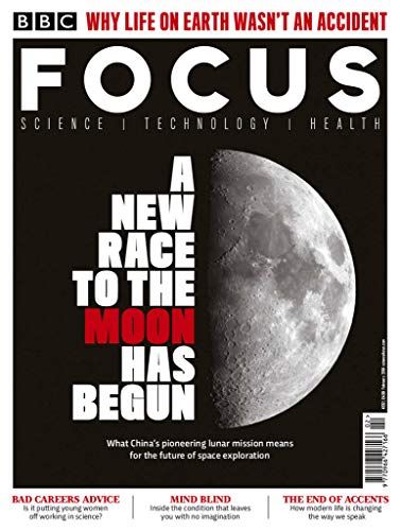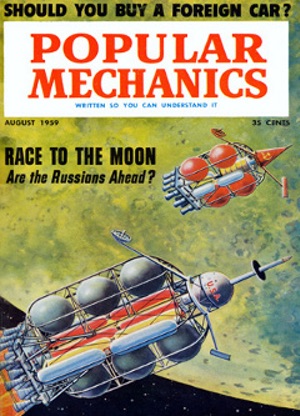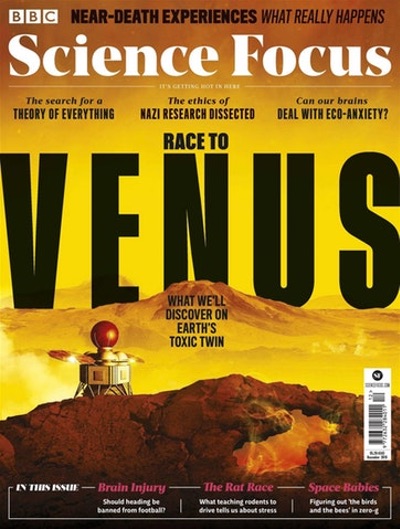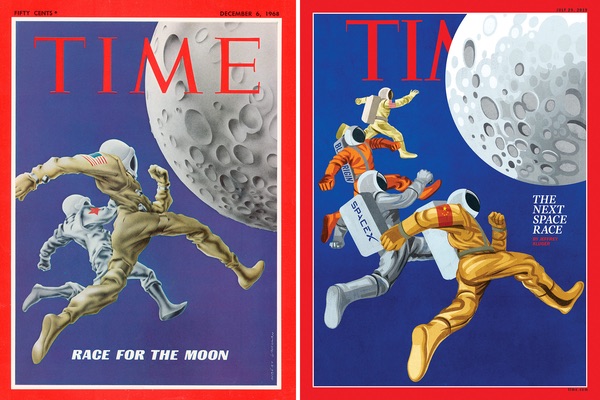Racing to where/what/when/why?by Dwayne A. Day
|
| “Space race” is a sloppy phrase being used to little effect other than hyperbole, and will ultimately signify nothing. But along the way, people are making a lot of noise. |
Wohlstetter made a valid point that the term “arms race” was used haphazardly and without precision, less of a description than ideological jargon. Despite his efforts and his logic, the term had a strong hold on the vernacular and “arms race” continued in popular use even though it lacked any coherent descriptive power.
Something like that is currently happening today with the term “space race,” which is now being bandied about by journalists and bloggers and politicians with abandon, with very few of them ever bothering to take the time to define what it is that they mean. It’s a sloppy phrase being used to little effect other than hyperbole, and will ultimately signify nothing. But along the way, people are making a lot of noise.
Racing to what?
One can in fact make a much better argument for the existence of the Cold War “space race” during the 1960s than a current space race. During the Cold War, there was an obvious action-reaction dynamic, there were clear milestones (generally reduced to engineering accomplishments measured in “firsts”), and an ultimate goal: landing humans on the Moon. John F. Kennedy even provided a deadline for the goal: “before this decade is out.” Thus, the space race of the 1960s was measurable and finite, unlike the so-called arms race, where Wohlstetter noted nobody could even agree if the units of measurement were numbers of weapons, budgets, or weapons performance characteristics.
Consider a number of obvious Cold War space race “firsts”:
- First satellite
- First man in space
- First woman in space
- First spacecraft to fly past the Moon
- First spacecraft to fly to Mars
- First spacecraft to crash into the Moon
- First spacecraft to softly land on the Moon
- First three-person spacecraft
- First spacewalk
- First successful rendezvous in orbit
- First mission to send astronauts around the Moon
- First mission to land astronauts on the Moon
The action-reaction nature of the Cold War space race sometimes involved preemption, not simply reaction after the fact. A perfect example was the risky Soviet launch of three cosmonauts aboard Voskhod 1 in October 1964. The Soviet Union thereby put three people in space at a time when NASA was gearing up to launch its two-man Gemini spacecraft. In order to fit three cosmonauts into the two-person spacecraft they flew without pressure suits, a major risk at the time. The Soviet Union did not fly a three-person Voskhod again, having achieved their propaganda victory.
The Gemini era offers some interesting lessons on how reductionist this obsession with “firsts” could be. In March 1965, Alexei Leonov achieved another major first when he performed a spacewalk outside his craft. But the Soviet Union then stopped flying manned spacecraft for several years, while the United States launched multiple Gemini missions, conducted multiple spacewalks, developed many new operational capabilities, and dramatically surpassed the Soviet Union in total man-hours in space (not merely a propaganda feat, but a measurement of human spaceflight and operations experience.) In terms of overall experience and ability, the United States far surpassed the Soviet Union at this time, achieving a lead that was never relinquished. But what everybody remembers is the first spacewalk.
Unfortunately, the lesson that we seemed to learn from this early experience is that stunts, in the form of “firsts,” are important, perhaps more important than real capabilities. Even today there are those who try to exhort new “firsts” in spaceflight which have become more narrow, obscure, irrelevant, and sometimes downright ridiculous.
 |
Neverending races
Like the so-called “firsts,” the phrase “space race” has persisted long after any such space race existed. Today, “space race” is often used by two groups: journalists who need a shorthand way to describe space activities and/or are too lazy to come up with something better, and advocates and politicians with agendas, trying to provoke a reaction and hoping that they can spur Western space activities by warning of a threat from China. Neither group may have even put much thought into whether a real race is occurring, and neither group may actually care if it is not. Both groups don’t know what they mean by space race, but want a term that they think applies to competition between countries in space, whether there actually is any competition. They know that a space race occurred in the past, and assume that it is happening now, even if the actual events and motivations are significantly different.
Vice President Pence’s mention of a space race during a speech last year demonstrated the vague thinking about this new space race:
Now, make no mistake about it: We’re in a space race today, just as we were in the 1960s, and the stakes are even higher. Last December, China became the first nation to land on the far side of the Moon and revealed their ambition to seize the lunar strategic high ground and become the world’s preeminent spacefaring nation. And for more than seven years, without a viable human space launch program of our own, Russia has been charging the United States more than $80 million a seat every time an American astronaut travels to the International Space Station. But it's not just competition against our adversaries; we’re also racing against our worst enemy: complacency. And the truth is, we’ve been here before.
| Today, “space race” is often used by two groups: journalists who need a shorthand way to describe space activities and/or are too lazy to come up with something better, and advocates and politicians with agendas, trying to provoke a reaction and hoping that they can spur Western space activities by warning of a threat from China. |
Two of the examples that Pence chose to indicate a space race—China’s landing of a spacecraft on the lunar farside, and Russia’s charging money for seats on its Soyuz spacecraft—are not new or sudden developments. China has discussed its robotic lunar plans since the mid-2000s. If anybody in the United States government had considered them to be signs of competition with the United States, NASA could have initiated a response many years ago in the form of a strategically directed robotic lunar exploration program. The United States was fully capable of landing robotic craft on the Moon a decade ago, but chose not to, deciding instead to send rovers to Mars and spacecraft to other planets.
Similarly, the reason Russia is launching American astronauts is because of decisions made in the United States not to move more quickly to develop American human spaceflight capability. But at the same time, the United States government and private actors made other decisions that have surpassed Russian capabilities in other areas. If Russia charging for seats on its rockets since the shuttle’s retirement is an example of competition, one could point to the United States (essentially, SpaceX) capturing much of the commercial space launch market from Russia during the same period. Dominating the commercial launch market is clearly preferable to being able to sell a limited number of Soyuz seats.
As to the Moon being “strategic high ground,” this is a claim that has been around since the 1950s when some military leaders first proposed basing nuclear weapons on the Moon. In January 1958, Air Force Brigadier General Homer Boushey gave a talk in Washington and stated that “he who controls the Moon controls the Earth.” Several studies of military lunar bases were conducted over the next few years, but they all reached the same conclusion that a “high ground” that is distant from Earth is not really a high ground at all. (See: “Take off and nuke the site from orbit (it’s the only way to be sure…)”, The Space Review, June 4, 2007).
An article by John Logsdon in the April 2019 issue of Aerospace America (“There is no space race”) made a similar argument about the need for goals and a willing competitor: “The current U.S.-China relationship is not such a race. It is not driven by schedule or deadlines or by seeking a specific goal. Rather, it is an ongoing, high-stakes competition for space achievements and innovative approaches to accomplishing them. Both countries are setting out space plans that reflect their own interests and aspirations rather than the quest to be ‘first.’”
As Logsdon noted in his article:
Competition in space is taking place in the context of the broader contest of developing advanced technologies such as artificial intelligence, quantum computing, advanced pharmaceuticals, and high-value manufacturing. Both countries recognize that a leading position in such areas is the foundation of 21st-century economic and military power. Both aspire to be at the leading edge of technological innovation. The competition is also geopolitical. The U.S. intends to remain the world’s leading power and guarantor of a world order based on democratic politics and free market economics, a position it has held since the end of World War II. China is challenging that hegemonic status, seeking to become the dominant global country, spreading its authoritarian approach to governance and its state-centered approach to social and economic development. Both countries recognize that space achievements, in addition to their tangible benefits, remain potent symbols of a nation’s vitality.
Even a competition is not necessarily a “race,” and actions by one side are not clearly resulting in responses by the other side. Logsdon noted that NASA Administrator Jim Bridenstine tweeted congratulations to China as Chang’e-4 landed on the lunar farside. But Logsdon also wrote that the fact “that China got more propaganda benefit from the Chang’e 4 landing than the U.S. did from flying the New Horizons probe precisely by the space rock Ultima Thule 6 billion kilometers from Earth suggests the advantage of being the new entry in the space competition.” He added that “In that ongoing competition, the reality is that both countries can take a leading position — there is no need for there to be only one leader.”
 |
Racing when?
Despite some alarmist articles that China will control cislunar space, seize lunar resources to boost its economy and deny them to others, or is even about to “speed up” its lunar exploration program, an examination of the recent historic record provides evidence to the contrary, indicating that if anything, China may be slowing down its civil space program—not at all what you would expect in a space race.
| Can we really believe that China is about to send humans to the Moon in the near-term and be “the first to settle the lunar surface” when their primary civil space goal—that they have discussed for almost a decade and a half—has apparently slowed down? |
Take, for example, China’s planned Chang’e-5 lunar sample return mission. That mission was first publicly revealed by the Chinese in 2006 (See: “China, cooperation, competition,” The Space Review, April 10, 2006) as a goal for 2017. At the time, it was common for Westerners to misinterpret that plan as a human lunar landing mission. Some even argued that NASA needed to work hard to land humans on the Moon before the Chinese did it in 2017. (See: “Red Moon revisited,” The Space Review, March 11, 2019.) But the Chinese mission slipped, from 2017 to 2019. China suffered setbacks with its Long March 5 rocket that is required to carry the heavier Chang’e-5 spacecraft.
The Chang’e-5 mission was rescheduled for launch by late 2019 and has now been pushed to later this year, or three years later than China’s originally stated plan. The overall lesson here is that China established a lunar sample return goal 14 years ago and they are still maintaining that goal, but they have slipped their schedule. This is not a sign of a country engaged in racing the Americans to lunar goals.
Or take the other major example, China’s plans for a human space station in low Earth orbit. Chinese officials initially announced plans to develop an orbiting space station by 2020. That has now slipped to 2022, and there are some indications that the station may not be permanently occupied until 2024. At least some of this delay is due to the same rocket vehicle development problems affecting Chang’e-5. But it is also reminiscent of what happened in the early 2000s when Westerners tried to portray China’s newly-developed Shenzhou piloted spacecraft as an emerging and imminent military threat, only to go quiet after the Chinese launched them infrequently. Can we really believe that China is about to send humans to the Moon in the near-term and be “the first to settle the lunar surface” when their primary civil space goal—that they have discussed for almost a decade and a half—has apparently slowed down?
Racing to what?
Since deadlines are amorphous and inconstant, and capabilities are not equivalent, is there any other measure of a goal for a space race? Some have claimed that the goal is lunar resources, which they have primarily defined in two ways: lunar water ice, and access to near-permanent sunlight at the lunar south pole. But the presence of lunar water ice is a topic with significant unknowns. Scientists still do not know what form it may take, which poses a major obstacle to accessing it. Even if it is all conveniently in the form of giant ice chunks located shallowly below the lunar surface, accessing it would still require operating in temperatures lower than any mechanically complex spacecraft has ever encountered. Beyond that, turning it into something useful like hydrogen and oxygen will take enormous amounts of energy (water exists because these two atoms enjoy sticking together), requiring substantial infrastructure to construct and support. This is not like panning for gold, and would require significant scientific, research and development, and logistics efforts.
 |
Racing to why?
Finally, one of the problems in trying to equate a space race today to the Cold War space race is that the aims of the two major competitors are different. During the Cold War, the United States and the Soviet Union were trying to win converts to their ideological, political, and economic systems. Many countries throughout the world were evaluating capitalism versus communism for their own futures. The United States and Soviet Union competed in many domains, including space, to prove the superiority of their systems.
| If you cannot define the where, what, when, or why, then it is not a race. |
That is no longer the case. A major reason China’s civil space program exists is for domestic consumption. But the international context has also changed. As Jessica Chen Weiss wrote in a recent issue of Foreign Affairs, China is more interested in making the world safe for itself, in part by developing political and economic ties with other countries, than it is in converting other countries to its political system. Thus, China is not using its civil space program to win converts, but to indicate its capabilities on the world stage.
A race or a crowd?
Returning to Wohlstetter, as he noted in his 1974 article, it’s hard to define a race if nobody can agree on the units of measure or the goals. Is the current alleged space race about meeting specific deadlines like Kennedy’s “before this decade is out” milestone? No, clearly not. Is it about “strategic high ground” on the Moon? Since that “strategic high ground” has not been clearly defined by anybody, and there’s no substantial body of literature describing what it is in terms that the majority of parties can agree on, the answer is also no. Is it about resources like lunar ice? Well, maybe. Except for the fact that the form and amount and accessibility of lunar ice is still very poorly defined. And what other resources are there on the Moon that are worth the cost of accessing them? Again, there’s no clear objective.
There can still be a threat without a race. There can even be competitors without there being a race. But space race is not a useful concept. If you cannot define the where, what, when, or why, then it is not a race.
Note: we are temporarily moderating all comments submitted to deal with a surge in spam.
